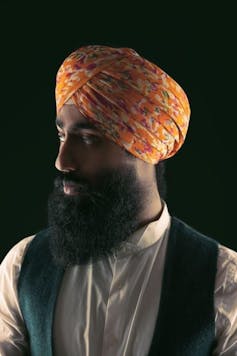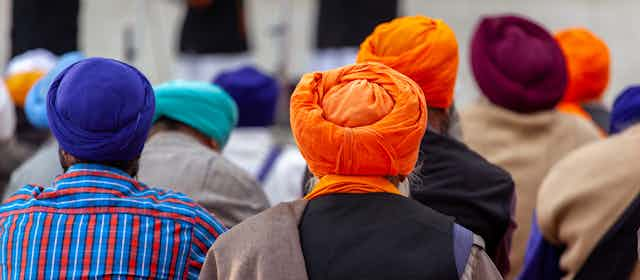The dastaar – most commonly referred to as a turban – is perhaps Sikhism’s most visible expression of identity.
As part of our ongoing research, we talked to 13 British Sikh men to learn about their identity, religious practice and their experiences of wearing the turban in the UK. They told us that they hoped the recent visibility of the turban in fashion collections, police uniform and advertising campaigns would help to dilute the stigma surrounding the turban.
In recent years, several projects have sought to promote Sikhism positively in an effort to reclaim narratives around the turban. In the UK, the Sikh Project art exhibition, fashion blogs such as Singh Street Style and YouTube creators tying the turban on camera have contributed to this.
Other noteworthy cases include the 2022 recruitment campaign for the Royal Navy, which exposed the traumas and stigmas associated with keeping hair and wearing a turban for a young Sikh man in Britain.
The Sikh code of discipline – the Rehat Maryada – states that Sikh men must cover their heads. While most Sikhs in the UK and around the world do not wear the turban, it remains the most recognisable article of faith for adult Sikh men and women.
There has been a Sikh presence in Britain for almost 160 years, but Sikh migration to the UK mostly started in the 1950s.
People (mostly men) from the Punjab region of India – and later from east Africa – responded to Britain’s call to the Commonwealth to participate in its postwar reconstruction efforts. Sikh migrants mostly found work in industries like foundries and textiles.
According to the 2021 census, there are about 524,000 Sikhs (0.9% of the population) in England and Wales and around 10,000 in Scotland (0.2% of the Scottish population). This population has higher than average levels of education and employment in professional and managerial occupations.

The first Sikh migrants to Britain faced significant discrimination in securing employment and many had to forgo their identities, resulting in the removal of all outward religious symbols including turban, hair and beard. Having to abandon the dastaar and cutting their hair were not benign acts:
It hurts. It really hurts. Why should you lose your identity to gain economic advantage? There was a pressure to change my appearance. Punjabis came to this country, they were misled in a way and told: ‘come on, let’s get your hair cut’ […] When you are born as something, and you cut your hair, deep down it hits you. It hits you all the time. – Gurtej, 68

More recently, British society has positively responded to inclusion of Sikh ways of life, with the acceptance of the turban in police and military uniforms. But there have also been real challenges and struggles along the way.
Most notably, stigmas and discrimination around the turban were exacerbated following the 9/11 World Trade Center terrorist attacks in 2001.
Alongside Muslims, turban-wearing Sikhs have borne the brunt of the subsequent rise in hate crimes, anti-Islamic sentiment, discrimination and racial profiling worldwide.
The Sikh men we spoke to for our as yet unpublished research, explained how wearing the turban signalled their observance to Sikhism and the life choices this entails, such as the protection of and service to others:
For me, what the turban signifies is a unique identity. To stand out in a crowd of millions is an act of real courage. […] if you need me, I am here for help. If you need food and shelter, this turbaned Sikh will give you food and shelter. It’s about courage, human rights, equality, it’s about commitment, discipline, it’s about compassion. Jagpal, 47
The dastaar holds both practical and spiritual significance:
Apart from the practical use of covering my long hair … the other reason for the turban is to protect the spiritual centre on top of the head so that it doesn’t get damaged in any way. When I meditate with my turban on my head, I feel happy and very good, the turban concentrates those happy feelings. Jagpal
Big brands have recently begun featuring turban-wearing models including Louis Vuitton, H&M, The Gap, Burberry and more controversially, Gucci at the 2019 Milan Fashion Week.
Some of our interviewees hoped that this visibility would help dilute the stigma surrounding the turban:
Whatever medium takes [the turban] away from terrorism, is a great thing. I don’t really care if it’s a catwalk, or young dapper Sikhs wearing designer clothing … I think anything that separates the turban from Bin Laden and those images all over the media after 9/11 and takes the turban into the realm of a Sikh perspective [is] great. Jagpal
Kuldeep, 27, who runs a successful fashion blog, spoke of his desire to feature his difference and break stereotypes. However, other interviewees expressed discomfort regarding the new found popularity of the dastaar in marketing campaigns and its commodification as a fashion item.
The striking visual of a fully observant Sikh keeping hair (kesh) and wearing the dastaar is part of its appeal for marketeers who seek to signal their inclusive values. Interviewees generally implied, however, that simply prioritising the visual aspects of the turban would come at the expense of its symbolic and spiritual dimension.
There is a genuine concern that those representations created for mainstream marketplace consumption may strip the dastaar of its metaphysical and symbolic value and turn it into a commercial commodity, the next cool must-have “cultural” accessory to be consumed by the masses.
As many interviewees explained, to them, the dastaar is so much more. It is not only a symbol of faith and a life of service, but also an embodiment of its long heritage and sacrifice borne by the Sikh community.

